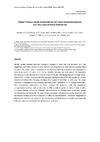Identificador persistente para citar o vincular este elemento:
https://accedacris.ulpgc.es/jspui/handle/10553/17913
| Título: | Phenotypically linked dichotomy in sea turtle foraging requires multiple conservation approaches | Autores/as: | Hawkes, Lucy A. Broderick, Annette C. Coyne, Michael S. Godfrey, Matthew H. Lopez-Jurado, Luis Felipe López, Pedro Merino, Sonia Elsy Varo-Cruz, Nuria Godley, B. J |
Clasificación UNESCO: | 24 Ciencias de la vida 2401 Biología animal (zoología) 240116 Herpetología 240123 Vertebrados 240119 Zoología marina |
Palabras clave: | Marine Turtles Satellite Tracking Caretta-Caretta Loggerhead Habitat, et al. |
Fecha de publicación: | 2006 | Publicación seriada: | Current Biology | Resumen: | Marine turtles undergo dramatic ontogenic changes in body size and behavior, with the loggerhead sea turtle, Caretta caretta, typically switching from an initial oceanic juvenile stage to one in the neritic, where maturation is reached and breeding migrations are subsequently undertaken every 2-3 years [1-3]. Using satellite tracking, we investigated the migratory movements of adult females from one of the world's largest nesting aggregations at Cape Verde, West Africa. In direct contrast with the accepted life-history model for this species [4], results reveal two distinct adult foraging strategies that appear to be linked to body size. The larger turtles (n = 3) foraged in coastal waters, whereas smaller individuals (n = 7) foraged oceanically. | URI: | https://accedacris.ulpgc.es/handle/10553/17913 | ISSN: | 0960-9822 | DOI: | 10.1016/j.cub.2006.03.063 | Fuente: | Current Biology[ISSN 0960-9822],v. 16, p. 990-995 |
| Colección: | Artículos |
Citas SCOPUSTM
185
actualizado el 08-jun-2025
Citas de WEB OF SCIENCETM
Citations
178
actualizado el 08-jun-2025
Visitas
74
actualizado el 30-sep-2023
Descargas
216
actualizado el 30-sep-2023
Google ScholarTM
Verifica
Altmetric
Comparte
Exporta metadatos
Los elementos en ULPGC accedaCRIS están protegidos por derechos de autor con todos los derechos reservados, a menos que se indique lo contrario.
